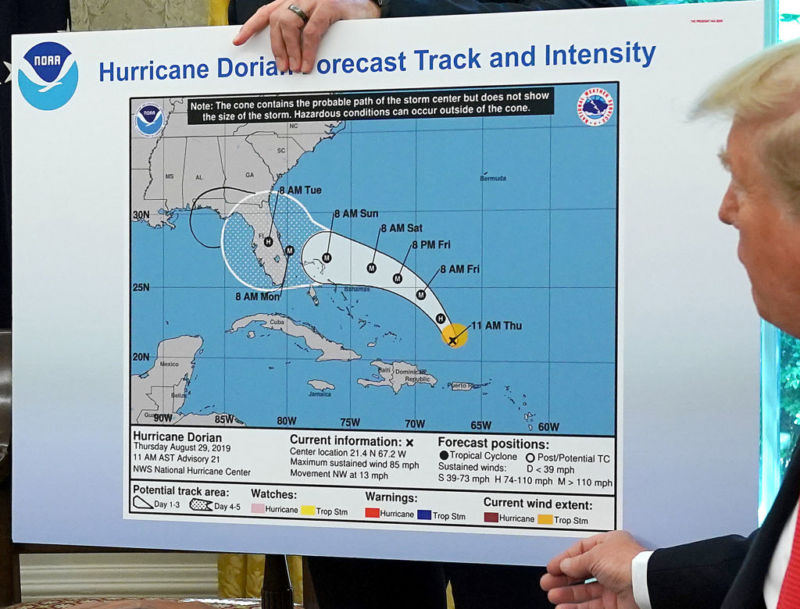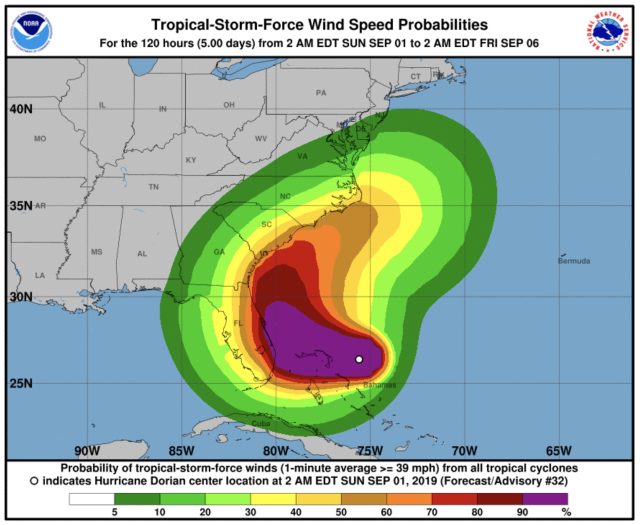

reader comments
433 with 188 posters participating
The White House pressured the National Oceanic and Atmospheric Administration into backing President Trump over weather forecasters who disputed Trump’s incorrect claim that Hurricane Dorian would likely strike Alabama, according to news reports.
“Mick Mulvaney, the acting White House chief of staff, told Wilbur Ross, the commerce secretary, to have the National Oceanic and Atmospheric Administration publicly disavow the forecasters’ position that Alabama was not at risk,” the New York Times reported today, citing anonymous sources. Ross then warned NOAA “that top employees at the agency could be fired if the situation was not addressed,” the Times wrote.
Mulvaney took this action after “President Trump told his staff that the [NOAA] needed to correct a tweet that seemed to contradict his statement that Hurricane Dorian posed a significant threat to Alabama as of Sept. 1,” the Washington Post wrote in an article on the same topic. There are now multiple investigations into whether the NOAA’s scientific integrity and independence were undermined.
Trump vs. National Weather Service
On the morning of September 1, Trump tweeted that Alabama “will most likely be hit (much) harder than anticipated.”
But the official forecast at the time showed a probable path for the storm center that did not include Alabama at all. The National Weather Service office in Birmingham, Alabama, subsequently tweeted that “Alabama will NOT see any impacts from Dorian” because “the system will remain too far east.” (The National Weather Service is part of NOAA.)
Despite that, Trump on September 4 gave a video message and showed a doctored forecast map in which black marker had been used to include Alabama in the hurricane’s potential path.
Mulvaney’s intervention apparently led to a September 6 statement from NOAA that rebuked the Birmingham National Weather Service for “sp[eaking] in absolute terms that were inconsistent with probabilities from the best forecast products available at the time.”
To back Trump’s position, the NOAA statement pointed to a wind-speed probability graphic, saying that it “demonstrated that tropical-storm-force winds from Hurricane Dorian could impact Alabama.” But the graphic showed that by the morning of September 1, forecasters predicted less than a 10% chance of tropical storm-force winds reaching a small part of southeast Alabama. The rest of Alabama faced no risk of tropical storm-force winds. By definition, tropical storm-force winds are between 39 and 73mph, while hurricanes start at 74mph.

Multiple investigations ongoing
The Commerce Department’s inspector general “is investigating how that [NOAA] statement came to be issued, saying it could call into question scientific independence,” the Times wrote. The House of Representatives committee on science, space, and technology is also investigating.
NOAA Research Assistant Administrator Craig McLean wrote a message Monday to all NOAA Research employees addressing what he called “a complex issue involving the President commenting on the path of the hurricane.” McLean wrote that the NOAA press release backing Trump’s position is “very concerning as it compromises the ability of NOAA to convey life-saving information necessary to avoid substantial and specific danger to public health and safety.
“My understanding is that this intervention to contradict the forecaster was not based on science but on external factors including reputation and appearance, or simply put, political,” McLean wrote in the message, which was published on the NOAA website.
McLean backed the forecaster or forecasters who contradicted Trump, saying they “corrected any public misunderstanding in an expert and timely way, as they should.” McLean also wrote that the press release “violated NOAA’s policies of scientific integrity.”
McLean is not done investigating the matter. “In my role as Assistant Administrator for Research, and as I continue to administratively serve as Acting Chief Scientist, I am pursuing the potential violations of our NOAA Administrative Order on Scientific Integrity,” he wrote.


